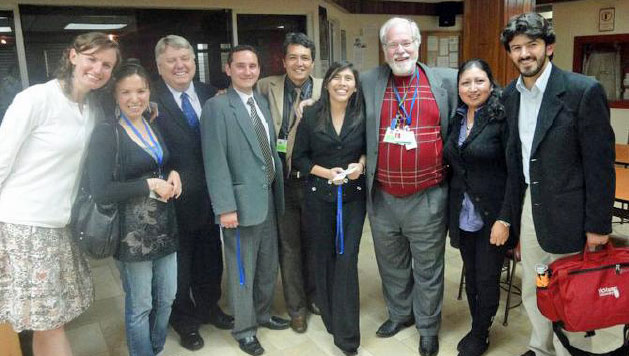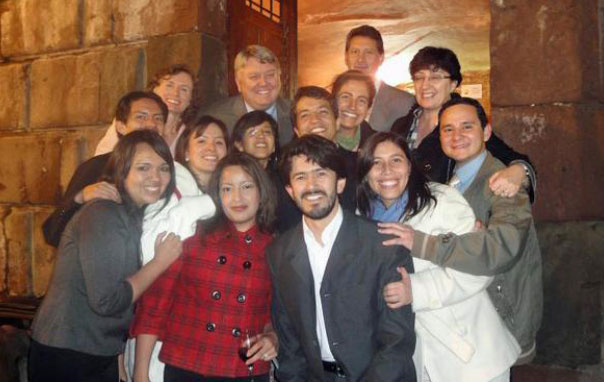From the President: Family Medicine on Top of the Middle of the World
Quito sprawls like a reversed ‘S’ along the Guayllabamba river basin in north-central Ecuador. Situated at 2,800 meters (9,200 feet), it is the highest legal capital in the world. To the west is the slumbering old volcano Rucu Pichincha (4,700 m), with its younger counterpart Guagua Pinchincha (4,794 m) sputtering nearby. On cloudless days, the snow-capped volcano Cotopaxi (5,753 m or 1,8874 ft) can be seen to the north. In the middle of the city rises El Panecillo (3,016 m or 9,895 ft), on top of which is an aluminum statue of the Virgin Mary watching over the city.
With its low-rise profile and many large parks, Quito feels livable even with two million inhabitants. Looking up at the peaks, while straddling la mitad del mundo (“the middle of the world”), the Ecuadorean name for the equator; I felt like I was standing on top of the middle of the world. As I came to learn during my recent visit to Quito, this seemed an apt description for the state of Family Medicine in Ecuador, and much of the world.
 Wonca president Rich Roberts with a group of colleagues, in Ecuador, including SEMF president, Dr Sanchez (center), and Dr Rodney (third from r).
Wonca president Rich Roberts with a group of colleagues, in Ecuador, including SEMF president, Dr Sanchez (center), and Dr Rodney (third from r).
Invited by the Sociedad Ecuatoriana de Medicina Familiar (SEMF), I was asked to speak at the XXIV Jornadas Médicas Internacionales Vozandes 2011. The conference drew about 400 registrants, with another 150 participating virtually through a web-based network. The educational sessions reflected the wide range of skills needed by Ecuadorean family doctors, with workshops on electrocardiography, obstetrical ultrasound, and doctor-patient communication. There were courses on advanced life support in cardiac care (ACLS), obstetrics (ALSO), and pre-hospital trauma (PHTLS). Lectures addressed a number of diverse topics including domestic violence, chronic disease, prenatal care, HIV-AIDS, and epidemiology. It was an excellent meeting with interesting and informative presentations. Most exciting was learning that Ecuador has embarked on an initiative to put Family Medicine at the center of its national health reform agenda.
 Rich Roberts surrounded by enthused young colleagues on the last night of the conference in Ecuador.
Rich Roberts surrounded by enthused young colleagues on the last night of the conference in Ecuador.
Ecuador has set a goal to have 4,000 qualified family doctors within the next five years. A recent constitutional amendment makes health care a basic human right. The government has proposed a program of universal coverage for basic health care. National leaders understand that this goal will not be met without adequate numbers of primary care professionals. Ecuador’s significant revenues from petroleum and minerals place them in the enviable position of having the financial resources to accomplish the changes needed to meet their health care goals. A major limiting factor however, will be their ability to train and retain sufficient numbers of family doctors.
Over the past two decades about 250 qualified family doctors have completed the three year Family Medicine Residency curriculum after six years of medical school. While there are 15 medical schools in Ecuador graduating about 1,500 physicians each year, only 20 or so enter one of the three Family Medicine residency programs. Thus, with 13 million people served by 20,000 physicians, about 4,000 of whom are general doctors, Ecuador has a great need for more family doctors. The gap between the number of family doctors they have and the number they need is likely to grow without major changes in the training, support, and pay of family physicians.
The reasons for the gap are similar to those observed across the globe. Specialists are held in higher esteem and are paid more. The average family doctor earns about USD 20,000 per annum. The average specialist earns about double that amount, with some earning USD 80,000 annually. Even the better Family Medicine centers are under-resourced. Along with fellow American, Dr Bill Rodney, I visited one of the best centers. The four family doctors at “La Ecuatoriana” have worked hard to build the practice, since the 30-year old clinic was upgraded from general to family doctors, in 2006. The practice has grown substantially and serves a population of 16,000. Despite the doctors’ best efforts, patients often must travel 1-2 hours by bus, to the hospital, for many diagnostic and therapeutic services, that could be provided in the clinic. Bureaucratic policies and limited budgets constrain what the clinic can do. Not surprisingly, when we attended a community meeting of about 30 patients, one of the first requests was for easier access to specialists.
Against this backdrop, how can Ecuador achieve a nearly 20 fold increase in family doctors over the next five years? I believe they can do it through an approach that will require several strategies. The number of training programs and the number of graduates per program must be increased. These increases are important, not only to provide more practicing family doctors, but to have sufficient numbers of teachers and role models for medical students considering a career in Family Medicine. Ultimately, I believe that most of the needed family doctors will be drawn from the large pool of general physicians who will be interested in increasing their skills, and improving their pay, by becoming family doctors. Fortunately, Ecuador can look close to home for examples of how to increase the qualifications of practicing general physicians interested in becoming family doctors. Brazil posts qualified family doctors as tutors among general doctors in health centers, under the Family Health Program. Argentina has developed a distance learning program known as PROFAM, which provides on-line training to general doctors.
As my plane cleared the volcano peaks on my way home from Quito, I found myself asking two questions: Can Ecuador transform its health care system by providing universal coverage and putting family doctors at the center of it? Can Ecuador’s family doctors meet the high expectations that are being asked of them?
On the first question, my meetings with top officials at the three ministries responsible for health, development, and inter-agency coordination suggested that there is understanding, at the highest government levels, of the major changes that are urgently needed. Ecuador also appears to have the financial resources to accomplish those changes. It will be the leaders and their ability to redirect resources and bureaucrats that determine whether those changes actually occur.
As to the second question, I was most impressed with the energy and enthusiasm of the family physician leaders I met, such as SEMF President Dr Galo Sanchez. Ecuadorean family doctors are well trained and committed to helping their patients and communities. Even so, I could sense anxiety on the part of some of them about whether they were up to such a challenge, given their small numbers.
At a reception on the last night of the conference, one of the local family doctors wanted my opinion on whether Ecuador could accomplish these big changes in such a short time. I nodded toward Ecuador’s first family doctor – she had traveled some distance from her rural community to attend. I noted the busy medical school dean, a family doctor, who felt it important to attend. I pointed out the many young and enthused medical students and residents who enlivened the party. I told him that in response to such questions, I am often reminded of a quote from the anthropologist Margaret Mead. She was once asked how a small group of dedicated people could change the world. Her answer was,
“that is the only thing that ever has.”
As I travel the world learning and working to improve the health of all people by advancing Family Medicine, I am more certain than ever than our time has come. Leaders everywhere are eager to have more of what we have to offer. Our challenge is to deliver on the promise of Family Medicine. In this time of great flux in health care systems, I would urge all of us to watch – and help – as the family doctors of Ecuador lift its health care system to the top of the middle of the world.
Professor Richard Roberts